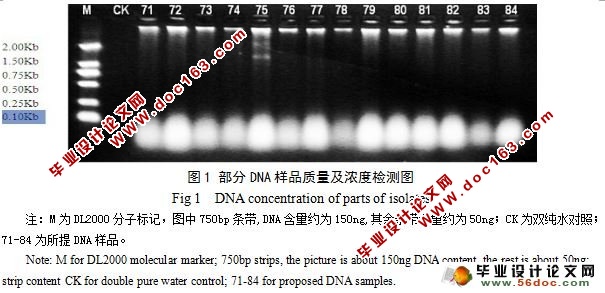湖南两个水稻病圃稻瘟病菌的遗传多样性比较

湖南两个水稻病圃稻瘟病菌的遗传多样性比较(毕业论文9700字)
摘 要:稻瘟病是水稻生产上最为严重的病害之一,稻瘟病菌(Magnaporthe oryzae)具有高致病变异性及复杂的遗传多样性,常导致抗病品种在种植3~5年后丧失抗性。本研究用10对SSR引物对采自湖南桃江和浏阳的162个稻瘟病菌进行遗传多样性分析。经(UPGMA)聚类分析,在0.80的相似水平上可划分为23个宗谱,L01宗谱为优势宗谱,占总菌株的72.8%,2个病圃都有菌株在L02、L04、L07、L13、L14、L20宗谱中;有一些宗谱只含有1个病圃的菌株,例如L05、L06宗谱等;2个病圃中稻瘟病菌具有相同的优势宗谱L01,并且它们存在自己独有的宗谱;如L03、L05宗谱只有桃江病圃的病菌;L09、L10宗谱只有浏阳病圃的病菌。由此可见,两地病圃稻瘟病菌群体的遗传组成上既存在一致性又存在一定特异性。
关键词:稻瘟病菌;病圃;SSR;遗传多样性
The Genetic Diversity Comparison of Magnaporthe oryzae in the Two Rice Blast Nurseries of Hunan
Abstract:Magnaporthe oryzae is one of the most widespread and destructive diseases in rice, and it has the highly pathogenic variation and complex genetic diversity, which often leads to resistance blast breakdown of the cultivars after planting 3 ~ 5 years. In study, the the genetic diversity of the 162 isolates of M. oryzae from Taojiang nursery and Liuyang nursery by using 10 pairs of SSR primer were analyzed. According to the UPGMA clustering analysis, 162 isolates can be classified into 23 lineages at the 0.8 similarity level, among which L01 is the superior one, accounting for 72.8%. In the two blast nursery, lineages, L02, L04, L07, L13, L14 and L20 had some simultaneous isolates , but L05 or L06 only distributed in the one blast nursery. The blast fungus lineages in the two blast nursery had not only with the common superior genealogy L01, but also with their unique ones. For instance, L03 and L05 lineages were only in Taojiang blast nursery, while L09 and L10 genealogies fell in Liuyang blast nursery. Therefore, the genetic composition of the M. oryzae in the above two nursery is not only featured with consistency but also with particularity.
Key words: Magnaporthe oryzae;Rice blast nurseries; SSR;Genetic diversity [资料来源:http://doc163.com]

目 录
摘 要 1
关键词 1
1 前言 2
1.1 分子生物学研究现状 2
1.1.1 RFLP技术 2
1.1.2 RAPD技术 3
1.1.3 AFLP技术 3
1.1.4 rep-PCR技术 4
1.1.5 SSR技术 4
1.2 研究目的 5
2 材料与方法 5
2.1供试材料 5
2.1.1 供试菌株 5
2.1.2 供试试剂 6
2.1.3 所用仪器 6
2.1.4 所用引物 7
2.2 试验方法 7
2.2.1 稻瘟病菌液体培养 7
2.2.2稻瘟病菌DNA提取 8
2.2.3 DNA质量检测 8
2.2.4 PCR扩增 9
2.2.5 琼脂糖凝胶电泳 10
2.2.6 数据处理 10
3 结果与分析 10
3.1 基因组DNA浓度检测 10
3.2 PCR扩增产物检测结果 11
3.3 病圃稻瘟病菌群体的遗传组成 12
3.4 相同水稻品种上病菌的遗传宗谱特点 13
3.5 空中捕捉稻瘟病菌遗传宗谱特点 13
4 讨论 14
参考文献 15
致 谢 17
